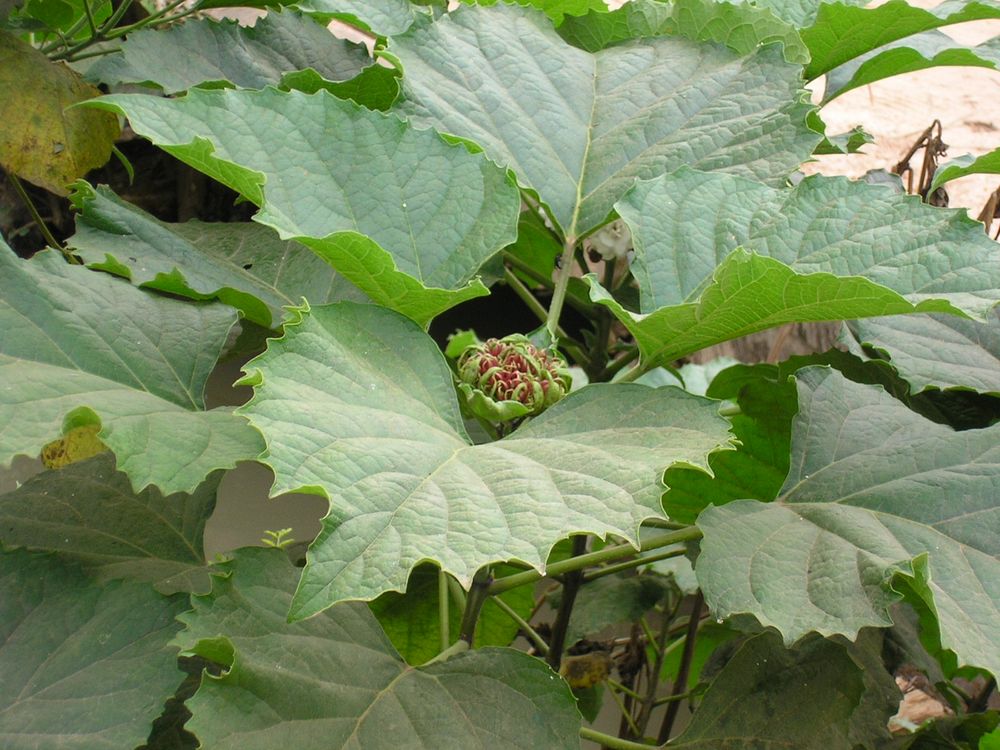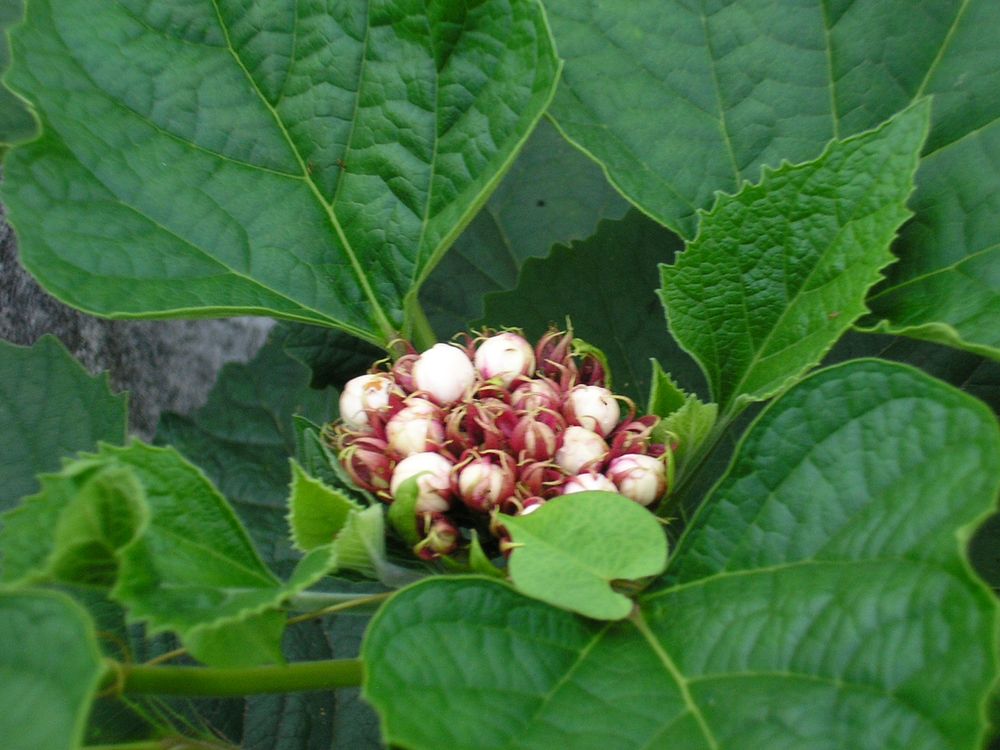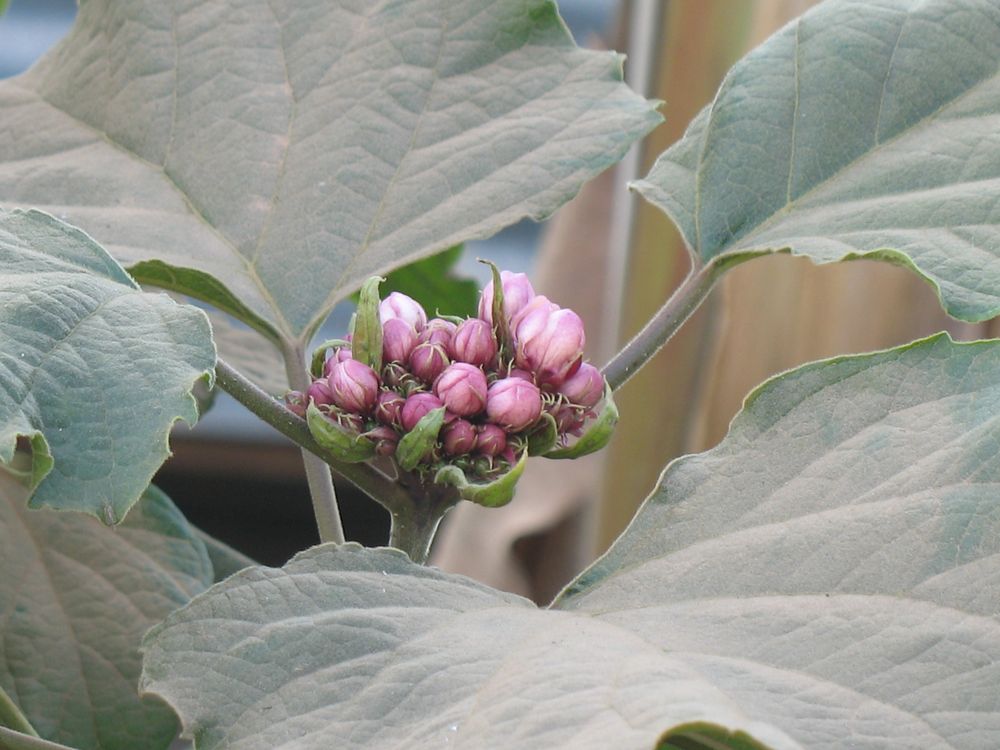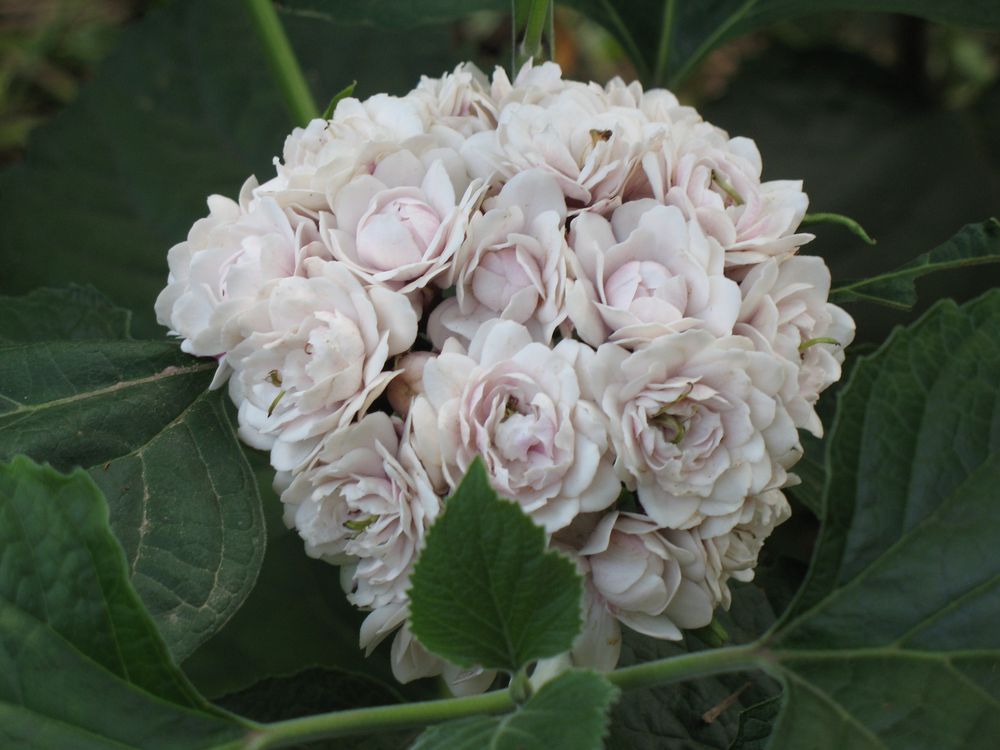It is surprising that this beautiful fragrant flower is so little appreciated by the Lao. It is rare or even non-existent in private gardens, there are a few plants in some Vats and in some fallow land. However, it is native to the region, southern China more precisely, and is grown in all tropical and even temperate countries because it tolerates low temperatures fairly well.
This Clerodendron is a shrub reaching 1m, with large heart-shaped leaves, dark green, and pubescent. The white or pinkish-white flowers, emerging from a red calyx, form corymbs of the most beautiful effect which are reminiscent of tight bouquets of small roses. They are delicately scented, moreover, in Lao, this plant is sometimes called dok son, a name given to jasmine; in Cambodia, Mr Martin notes that this Clerodendron is called “village jasmine” and that its fragrant flowers are offered to the Buddha. Nothing like this in Laos where the plant is completely ignored. The influence of Thailand may have something to do with it because, in this neighbouring country, there is a belief that the plant as it ages turns into a phi (ghost) disturbing the peace of the house by bombarding it with stones. Moreover, the Thai name Nang Yaem means “the young lady who takes a look” and it is sometimes found in Thai erotic texts. It must be recognized however that this beautiful Clerodendron is very invasive and tends to smother its neighbours. It has, despite everything, some medicinal virtues among the Laotians of the mountains who treat abdominal pain with a decoction of its roots.
Il est étonnant que cette belle fleur parfumée soit si peu appréciée des Lao. Elle est rare voire inexistante dans les jardins privés, on en trouve quelques pieds dans certains vat et dans quelques terrains en friche. Elle est pourtant originaire de la région, du Sud de la Chine plus exactement, et est cultivée dans tous les pays tropicaux et même tempérés car elle supporte assez bien les basses températures.
Ce Clerodendron est un arbuste atteignant 1m, aux grandes feuilles en forme de cœur, vert foncé, pubescentes. Les fleurs blanches ou blanc rosé, émergeant d’un calice rouge, forment des corymbes du plus bel effet qui font penser à des bouquets serrés de petites roses. Elles sont délicatement parfumées, d’ailleurs en lao on nomme parfois cette plante dok son, nom donné au jasmin; au Cambodge M. Martin note que ce Clerodendron est appelé « jasmin du village » et que ses fleurs odorantes sont offertes au Bouddha. Rien de tel au Laos où la plante est complètement ignorée. L’influence de la Thaïlande y est peut-être pour quelque chose car, dans ce pays voisin, une croyance a cours qui veut que la plante en vieillissant se transforme en phi (fantôme) troublant la paix de la maison en la bombardant de pierres. Par ailleurs le nom thaï Nang Yaem signifie « la demoiselle qui jette un coup d’œil » et on le rencontre parfois dans les textes érotiques thaï. Il faut bien reconnaître cependant que ce beau Clerodendron est très envahissant et a tendance à étouffer ses voisins. Il a, malgré tout, quelques vertus médicinales chez les Laotiens des montagnes qui traitent par une décoction de ses racines les douleurs abdominales.




It is surprising that this beautiful fragrant flower is so little appreciated by the Lao. It is rare or even non-existent in private gardens, there are a few plants in some Vats and in some fallow land. However, it is native to the region, southern China more precisely, and is grown in all tropical and even temperate countries because it tolerates low temperatures fairly well.
This Clerodendron is a shrub reaching 1m, with large heart-shaped leaves, dark green, and pubescent. The white or pinkish-white flowers, emerging from a red calyx, form corymbs of the most beautiful effect which are reminiscent of tight bouquets of small roses. They are delicately scented, moreover, in Lao, this plant is sometimes called dok son, a name given to jasmine; in Cambodia, Mr Martin notes that this Clerodendron is called “village jasmine” and that its fragrant flowers are offered to the Buddha. Nothing like this in Laos where the plant is completely ignored. The influence of Thailand may have something to do with it because, in this neighbouring country, there is a belief that the plant as it ages turns into a phi (ghost) disturbing the peace of the house by bombarding it with stones. Moreover, the Thai name Nang Yaem means “the young lady who takes a look” and it is sometimes found in Thai erotic texts. It must be recognized however that this beautiful Clerodendron is very invasive and tends to smother its neighbours. It has, despite everything, some medicinal virtues among the Laotians of the mountains who treat abdominal pain with a decoction of its roots.
Il est étonnant que cette belle fleur parfumée soit si peu appréciée des Lao. Elle est rare voire inexistante dans les jardins privés, on en trouve quelques pieds dans certains vat et dans quelques terrains en friche. Elle est pourtant originaire de la région, du Sud de la Chine plus exactement, et est cultivée dans tous les pays tropicaux et même tempérés car elle supporte assez bien les basses températures.
Ce Clerodendron est un arbuste atteignant 1m, aux grandes feuilles en forme de cœur, vert foncé, pubescentes. Les fleurs blanches ou blanc rosé, émergeant d’un calice rouge, forment des corymbes du plus bel effet qui font penser à des bouquets serrés de petites roses. Elles sont délicatement parfumées, d’ailleurs en lao on nomme parfois cette plante dok son, nom donné au jasmin; au Cambodge M. Martin note que ce Clerodendron est appelé « jasmin du village » et que ses fleurs odorantes sont offertes au Bouddha. Rien de tel au Laos où la plante est complètement ignorée. L’influence de la Thaïlande y est peut-être pour quelque chose car, dans ce pays voisin, une croyance a cours qui veut que la plante en vieillissant se transforme en phi (fantôme) troublant la paix de la maison en la bombardant de pierres. Par ailleurs le nom thaï Nang Yaem signifie « la demoiselle qui jette un coup d’œil » et on le rencontre parfois dans les textes érotiques thaï. Il faut bien reconnaître cependant que ce beau Clerodendron est très envahissant et a tendance à étouffer ses voisins. Il a, malgré tout, quelques vertus médicinales chez les Laotiens des montagnes qui traitent par une décoction de ses racines les douleurs abdominales.








It is surprising that this beautiful fragrant flower is so little appreciated by the Lao. It is rare or even non-existent in private gardens, there are a few plants in some Vats and in some fallow land. However, it is native to the region, southern China more precisely, and is grown in all tropical and even temperate countries because it tolerates low temperatures fairly well.
This Clerodendron is a shrub reaching 1m, with large heart-shaped leaves, dark green, and pubescent. The white or pinkish-white flowers, emerging from a red calyx, form corymbs of the most beautiful effect which are reminiscent of tight bouquets of small roses. They are delicately scented, moreover, in Lao, this plant is sometimes called dok son, a name given to jasmine; in Cambodia, Mr Martin notes that this Clerodendron is called “village jasmine” and that its fragrant flowers are offered to the Buddha. Nothing like this in Laos where the plant is completely ignored. The influence of Thailand may have something to do with it because, in this neighbouring country, there is a belief that the plant as it ages turns into a phi (ghost) disturbing the peace of the house by bombarding it with stones. Moreover, the Thai name Nang Yaem means “the young lady who takes a look” and it is sometimes found in Thai erotic texts. It must be recognized however that this beautiful Clerodendron is very invasive and tends to smother its neighbours. It has, despite everything, some medicinal virtues among the Laotians of the mountains who treat abdominal pain with a decoction of its roots.
Il est étonnant que cette belle fleur parfumée soit si peu appréciée des Lao. Elle est rare voire inexistante dans les jardins privés, on en trouve quelques pieds dans certains vat et dans quelques terrains en friche. Elle est pourtant originaire de la région, du Sud de la Chine plus exactement, et est cultivée dans tous les pays tropicaux et même tempérés car elle supporte assez bien les basses températures.
Ce Clerodendron est un arbuste atteignant 1m, aux grandes feuilles en forme de cœur, vert foncé, pubescentes. Les fleurs blanches ou blanc rosé, émergeant d’un calice rouge, forment des corymbes du plus bel effet qui font penser à des bouquets serrés de petites roses. Elles sont délicatement parfumées, d’ailleurs en lao on nomme parfois cette plante dok son, nom donné au jasmin; au Cambodge M. Martin note que ce Clerodendron est appelé « jasmin du village » et que ses fleurs odorantes sont offertes au Bouddha. Rien de tel au Laos où la plante est complètement ignorée. L’influence de la Thaïlande y est peut-être pour quelque chose car, dans ce pays voisin, une croyance a cours qui veut que la plante en vieillissant se transforme en phi (fantôme) troublant la paix de la maison en la bombardant de pierres. Par ailleurs le nom thaï Nang Yaem signifie « la demoiselle qui jette un coup d’œil » et on le rencontre parfois dans les textes érotiques thaï. Il faut bien reconnaître cependant que ce beau Clerodendron est très envahissant et a tendance à étouffer ses voisins. Il a, malgré tout, quelques vertus médicinales chez les Laotiens des montagnes qui traitent par une décoction de ses racines les douleurs abdominales.


